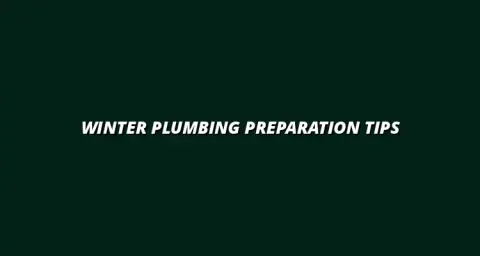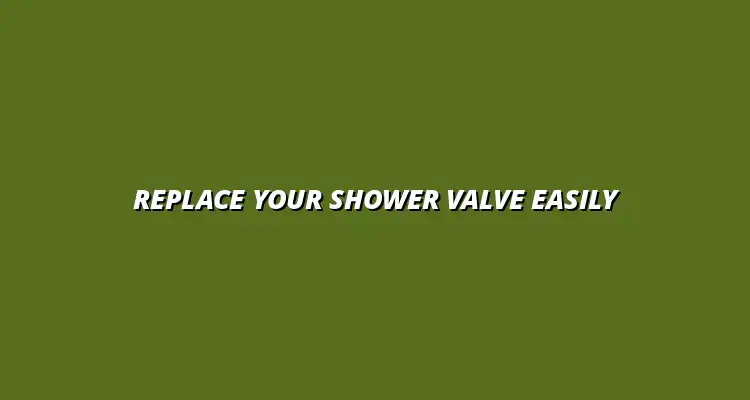
- Beginner Tips
- Jan 06
2025-02-19
Shower valves are a crucial component of any home plumbing system. They control the flow and temperature of water, ensuring a comfortable and enjoyable shower experience. Without a properly functioning shower valve, you could face issues like inconsistent water temperatures or even leaks, which can lead to bigger plumbing problems down the road. Understanding common plumbing problems like those affecting shower valves is a great first step to home maintenance.
In essence, the role of a shower valve extends beyond mere convenience; it plays a vital part in maintaining the overall efficiency of your plumbing. Whether you're taking a quick rinse or a long, relaxing shower, understanding shower valves helps homeowners make informed decisions about their plumbing systems.
A shower valve acts as a gateway between your home's water supply and the showerhead. This simple yet essential device regulates water pressure and temperature, allowing you to enjoy a pleasant bathing experience. When you turn the handle or press a button, the shower valve quickly adjusts to your settings, mixing hot and cold water to your preferred level.
Additionally, shower valves can help improve energy efficiency by limiting water usage. By controlling the flow, they ensure that you’re not wasting water while enjoying your shower. Understanding this role is crucial for maintaining a sustainable home. If you're tackling this project yourself, a helpful DIY shower valve installation guide can be a valuable resource.
When it comes to shower valves, there are three main types to consider: Compression valves, Cartridge valves, and Thermostatic valves. Each type has unique features and functions, allowing homeowners to choose based on their specific needs.
Identifying when your shower valve needs replacing can save you from larger plumbing issues. Common signs include leaks, which can be a clear indication of wear and tear. Knowing how to fix a leaky faucet can provide valuable experience applicable to shower valves. Additionally, you may experience low water pressure or fluctuating water temperatures, which often signal that the valve is malfunctioning.
Addressing these issues promptly not only improves your shower experience but also helps prevent more extensive damage to your plumbing system. Ignoring these signs might lead to costly repairs in the future!
Shower valves typically last between 10 to 20 years, depending on their quality and usage. To assess their condition, regularly check for rust, corrosion, or build-up around the valve itself. If you notice any of these signs, it may be time to consider a replacement. If you're dealing with other plumbing issues, you might need to call a plumber, like a plumber in Billesley, Birmingham.
It's also beneficial to keep a record of when you last replaced or serviced the valve. This history can help you determine when it might need replacement again, ensuring your plumbing remains in good shape.
Before tackling a shower valve replacement, gathering the right tools and materials is essential for a smooth process. Using the correct tools ensures that you can perform the replacement efficiently and without causing damage to your plumbing system.
Having everything ready will make the process much easier. Imagine the frustration of having to stop midway because you lack an essential tool! So let’s dive into what you’ll need.
Here’s a handy list of essential tools you’ll need for replacing your shower valve:
Using the right tools can make or break your shower valve replacement experience. Proper tools ensure that you can work efficiently and effectively, reducing the risk of mistakes that could lead to leaks or further damage. If you have a leaky kitchen faucet, learning how to fix a leaky kitchen faucet can help build your skills. Additionally, having the correct tools on hand may save you time and frustration during the process.
Ultimately, equipping yourself with the right tools not only boosts your confidence but also enhances your chances of achieving a successful valve replacement!
Choosing the correct replacement shower valve is key to ensuring optimal performance. Start by identifying the type of plumbing system you have, as this will guide you in selecting a compatible valve. Consider factors such as water pressure and temperature control, as these aspects can differ between homes.
Researching the specifications of each valve type will help you make an informed choice. Always consult your plumbing manual or a professional if you're unsure about compatibility! Replacing a worn-out showerhead is a simpler project, and a guide on how to replace your worn-out showerhead can be a good starting point.
Once you have narrowed down your options, consider how each valve type aligns with your current shower system. For example, if you have a high-flow showerhead, a thermostatic valve might be best to maintain a consistent temperature. If you're on a tight budget, a cartridge valve could be a cost-effective solution.
By matching the valve type to your specific needs, you can enhance the functionality and longevity of your shower system, providing a more enjoyable experience overall.
Maintaining your shower valve can significantly extend its lifespan and save you from costly repairs. Regular maintenance helps ensure that everything is functioning smoothly, and it can prevent minor issues from escalating into major problems. Here are some effective practices to keep your shower valve in top shape!
To keep your shower valve working efficiently, it’s important to clean and inspect it periodically. Start by turning off the water supply and removing any covers or trim to access the valve. Once exposed, check for any signs of wear or build-up, which can indicate issues that need to be addressed. Understanding how to repairing a water heater valve involves similar principles.
Some regular maintenance practices include:
By routinely checking for these issues, you can identify potential problems before they require major repairs. This proactive approach can save you time and money in the long run!
Even with regular maintenance, there may be times when you need to call in a professional. Some issues can be complex and might require specialized tools and experience. Recognizing when to seek help is crucial to avoid further damage.
Here are some signs that indicate a need for professional plumbing services:
Hiring a plumber can provide you with peace of mind, especially for complex plumbing systems. They have the experience to diagnose issues quickly and ensure that the repair is done correctly!
Many homeowners have questions regarding shower valve replacement. It’s essential to address these concerns to ensure a successful DIY project. Let’s dive into some of the most common FAQs!
The time it takes to replace a shower valve can vary depending on your experience and the complexity of the plumbing system. On average, you can expect it to take anywhere from 1 to 3 hours. However, this may increase if you encounter any unexpected issues during the process.
Absolutely! Many homeowners successfully replace their shower valves without professional experience. That said, it’s important to follow instructions carefully and ensure you have the right tools. If you’re unsure at any point, don’t hesitate to consult a professional or seek guidance!
For those looking to dive deeper into shower valve replacement, there are a wealth of resources available. These can help you gain a better understanding of the process and provide visual aids to guide you!
Here are some valuable resources:
These resources can empower you with knowledge and confidence as you tackle your home plumbing projects!
Taking on a DIY shower valve replacement can be an empowering experience. Not only does it give you the satisfaction of completing a home repair, but it also teaches you valuable skills that you can use in the future. Plus, there are financial benefits!
When you handle home repairs yourself, you gain a sense of independence and self-sufficiency. It’s rewarding to know that you can fix things around your home without relying on others. DIY projects can help you build confidence in your abilities!
Additionally, tackling these projects can lead to significant cost savings. Hiring a plumber can be expensive, so saving on labor costs allows you to invest those savings elsewhere. Overall, DIY shower valve replacement can be both fulfilling and economical!
